Shelf Styling Made Simple: Elegant Ways to Dress a Bookcase
Shelves do more than hold things. They tell a story about you. With a few smart moves, any bookcase, dresser, or open shelving unit can look calm, chic, and personal. This guide shares the same simple principles used in my Saturday Style Session so you can style your own shelves at home with ease.
We will keep it clear and practical. We will use easy rules that work every time: arrange in odd numbers, vary the heights, and build a “family” of objects that relate to each other without being matchy-matchy. These shelf styling ideas are simple to copy, budget-friendly, and look refined in any room.
The Three Golden Rules of Shelf Styling
1) Work in Odd Numbers
Odd numbers are pleasing to the eye. Style groups of 3, 5, or 7. A trio is the easiest place to start: one tall item, one medium item, and one small item. This creates rhythm and focus without fuss.
2) Vary the Heights (Think “Cityscape”)
Imagine a skyline. You want high-low-medium to keep the view lively. Use taller vases, stacked books, or framed art at the back, then step down to smaller pieces in front. Height changes add depth and make your shelves feel layered and rich.
3) Build a “Family” of Objects
Choose items that relate in some way: colour, material, mood, or theme. A brass vase, a frame with a warm wood tone, and a book with a tan spine all feel like cousins. Then add one “eccentric friend”, a quirky piece with character, to stop the arrangement from feeling flat. Related, not identical. Harmonious, not uniform.
How to Start: A Simple Step-by-Step
Clear the shelf. Start fresh so you can see the full space.
Set your anchors. Place taller items first (vase, framed print, sculpture).
Stack books for levels. Use horizontal book stacks as mini plinths for candles or bowls.
Build trios. Arrange in groups of three and repeat that rhythm along the shelf.
Vary shapes. Mix round (bowls), tall (bottles), flat (books), and soft (textiles).
Add the “eccentric friend.” A colourful object, a travel memento, or a vintage piece brings charm.
Edit. Stand back, squint, and remove one item. Breathing space makes it chic.
Styling Any Shelving Unit or Bookcase
These principles work on bookcases, built-ins, open kitchen shelves, dressers, and console units. The structure is the same; only the content changes. If you feel stuck, try this base formula for a single shelf:
Left: A tall vase or framed print
Centre: A stack of 2–3 books with a bowl or candle on top
Right: A small sculpture or box
Front: A small accent (bud vase, bead garland, or tealight) to add depth
Repeat the formula on the next shelf with different objects but keep the odd numbers, height changes, and family feel consistent.
Books Done Beautifully
Mix vertical and horizontal. Stand some books upright, then create a low “step” with a horizontal stack.
Hide the loud dust jackets. Slip them off to reveal neutral cloth spines for a calmer look.
Face-out a favourite cover. Use a small plate stand to display one beautiful book like art.
Colour coherence. You do not need a rainbow. A gentle palette looks relaxed and refined.
Objects That Always Work
Vases and bottles: Choose a few in ceramic, glass, or stone. Mix matte and gloss.
Boxes: Linen, leather, or bone boxes hide clutter and add clean lines.
Bowls: Great for keys, matches, or nothing at all, sometimes shape is the point.
Frames: Layer one small frame in front of a larger one to build depth.
Candles: Tapers in holders, a candle in glass, or a simple pillar add warmth.
Use these as your “family”; then bring in one character piece, a travel find, a vintage oddity, or a handmade item.
Materials and Texture: The Silent Styling Tool
A shelf feels rich when you mix three textures:
Something natural: wood, wicker, linen
Something smooth: glass, glazed ceramic
Something solid: stone, marble, metal
Keep the palette tight. For example: warm wood + cream ceramics + clear glass. Repeating those materials across shelves creates flow.
Colour That Feels Cohesive
Pick two main colours and one accent. Perhaps soft neutrals with touches of brass. Or whites and woods with a hint of coastal blue. Repeat these colours in spines, vases, and boxes so the look feels pulled-together rather than busy.
Layering: How to Create Depth
Back layer: Tall items or a leaning frame
Middle layer: Stacked books, medium vases, or boxes
Front layer: Small bowl, candle, beads, or a tiny bud vase
Layering stops shelves from looking flat. It draws the eye in, which is what gives that designer feel.
Scale and Negative Space
Good styling is as much about what you leave out. Give each trio a little space to breathe. Avoid a line of tiny objects, which reads as clutter. Choose fewer, larger pieces over many small ones.
Personal Stories, Not Perfect Sets
Shelves look special when they show you. Mix family photos, a frame from your travels, a child’s small artwork, or a shell from a favourite beach. These touches keep the look warm and lived-in, while the odd-numbers and varied heights keep it chic.
Kitchen Shelves: Pretty and Practical
Pair stacked bowls with a small jar of wooden spoons.
Use lidded jars for teas or spices and group them in threes.
Add a single plant for life and a small marble board for contrast.
Keep labels tidy and face them the same way, little details matter.
Living Room Bookcase: Calm and Collected
Place a tall vase on one side, a box on the other, and a book stack in the middle.
Tuck a candlestick beside a frame to add height.
Repeat the rhythm on the next shelf using different but related pieces.
Office Shelves: Order That Looks Smart
Keep a neutral palette to avoid visual noise.
Use storage boxes for cables and stationery and label discreetly.
Face-out a favourite book cover or small print to break up the rows.
Kids’ Rooms and Play Areas
Choose sturdy baskets at low level for easy tidying.
Rotate display items on upper shelves: one cute toy, one book, one framed print.
Keep colours soft with one bright accent so it feels playful but not chaotic.
Small Space Tricks
Go vertical. Use the full height of your unit to draw the eye up.
Mirror or glass. A reflective item bounces light and opens the view.
Edit often. Seasonal swaps keep shelves fresh and uncluttered.
Common Mistakes to Avoid
All the same height. Fix it by adding a tall vase or stacking books.
Too many small items. Group them on a tray or remove half.
Matchy-matchy sets. Swap one piece for your “eccentric friend” to add charm.
No breathing room. Remove one item per shelf; negative space is elegant.
A Quick Five-Minute Reset
Remove anything that does not belong.
Rebuild one trio with odd numbers and varied heights.
Add a small, personal object for heart.
Wipe the shelf and step back.
Edit one more thing. Less is more.
FAQ’s
-
Work in odd numbers, vary heights, and mix books with objects. A trio, tall, medium, small, on each shelf brings instant balance.
-
Layer items front to back, repeat a cohesive colour palette, and add one unexpected piece. Use fewer, larger objects to avoid clutter.
-
Try vases, bowls, boxes, framed art, candles, and travel mementos. Mix textures, wood, glass, and stone, for depth and interest.
-
Use boxes for small bits, keep labels neat, and leave space around each group. Edit regularly and stick to two main colours plus one accent.
The Finished Look: Relaxed, Polished, Personal
When you style shelves with odd numbers, varied heights, and a family of related objects, you create balance and ease. Your bookcase will feel curated, not cluttered. Your home will feel calmer, warmer, and more you. Stand back and enjoy the view. It looks good because it feels right.
You can head over to my YouTube channel to watch the video version of this blog post.




